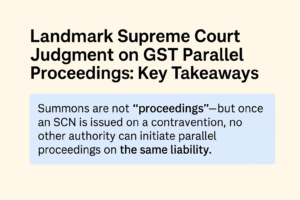Understanding the GST Appellate Tribunal (Procedure) Rules, 2025
On 24th April 2025, the Ministry of Finance notified the GSTAT (Procedure) Rules, 2025 through G.S.R. 256(E) under powers conferred by Section 111 of the CGST Act, 2017. These rules aim to regulate the functioning and procedural aspects of the Goods and Services Tax Appellate Tribunal (GSTAT) – the apex body for GST appeals.
CHAPTER I: Preliminary Provisions
- Short Title & Commencement: These rules are known as the GSTAT (Procedure) Rules, 2025, effective from their publication date in the Official Gazette.
- Definitions: Key terms like “Appellate Tribunal”, “President”, “Vice-President”, and “Registrar” are defined. All undefined terms carry the meanings assigned in the CGST, SGST, and UTGST Acts.
CHAPTER II: Powers and Functions
- Time Computation: Excludes the starting day and holidays when the office is closed.
- Format of Orders & Seal: Orders must bear the signature of the Registrar or authorized officer and the official GSTAT seal.
- Working Hours:
- Bench Sitting: 10:30 AM to 1:30 PM and 2:30 PM to 4:30 PM.
- Office: 9:30 AM to 6:00 PM.
- Inherent Powers: GSTAT retains inherent powers to ensure justice and prevent abuse of its process.
CHAPTER III: Institution of Appeals
- Filing Appeals:
- Filed online on the GSTAT Portal using prescribed forms.
- Only one appeal is needed even if the decision covers multiple show cause notices or refund claims.
- Accompanying Documents:
- Certified copies of impugned orders and all relied-upon documents must be submitted.
- Non-compliance may result in return/rejection of the appeal.
- Registrar’s Role:
- Responsible for scrutiny, registration, and accepting or rejecting filings.
CHAPTER IV: Cause Lists
- Daily cause lists are published on the GSTAT portal and notice board by the Registrar.
- Cases are listed in priority order: pronouncements, clarifications, admissions, etc.
CHAPTER V: Hearing of Appeals
- Hearing Rights: Both parties get a fair opportunity to be heard.
- Ex-Parte Orders: Tribunal may proceed in absence of a party.
- Adjournments & Additional Evidence: Can be allowed with valid reasons.
- Open Proceedings: Generally public unless confidentiality is ordered.
CHAPTER VI – XIII: Records, Registers, Orders, and Proceedings
These chapters provide detailed internal mechanisms for:
- Maintaining order sheets, cause lists, and court diaries.
- Examining witnesses, issuing commissions, and administering oaths.
- Issuing interlocutory orders, conducting inspections, and filing cross-objections.
- Pronouncing and publishing orders within 30 days of final hearing.
- Procedures for rectification, review, and enlargement of time.
CHAPTER XIV: E-Filing and Hybrid Proceedings
- All appeals and applications must be filed and processed electronically via the GSTAT Portal.
- Hearings may be held physically or virtually, as per President’s permission.
- All orders, notices, and replies are electronically maintained.
CHAPTER XV: Miscellaneous Provisions
- Fees Structure (Schedule of Fees):
- Inspection or Interlocutory Applications: ₹5,000
- True Copy Fee: ₹5 per page
- Professional Dress Code: Prescribed attire for members and authorised representatives.
- Empanelment of Experts: For technical assistance during hearings.
ANNEXURES (GSTAT Forms)
- GSTAT FORM-01: Interlocutory Application
- GSTAT FORM-02: Order Sheet
- GSTAT FORM-03: Inspection Application
- GSTAT FORM-04: Memorandum of Appearance
- GSTAT FORM-05: Affidavit for Illiterate/Visually Impaired Deponents
- GSTAT FORM-06: Summons Format
- GSTAT FORM-07: Witness Deposition Format
- GSTAT FORM-08: Witness Discharge Certificate
Conclusion
The GSTAT (Procedure) Rules, 2025 provide a well-structured, digitized, and fair appellate mechanism for resolving GST disputes. The rules not only streamline procedures but also ensure transparency, accessibility, and speed in the disposal of cases.
These comprehensive rules reinforce the government’s focus on robust institutional mechanisms and digital governance under the GST regime.



Add comment